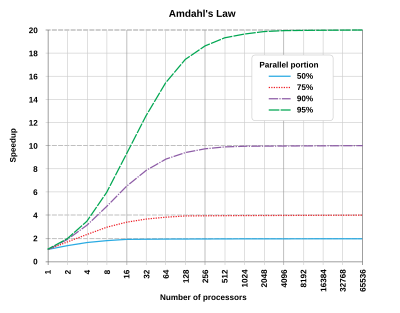
In computer architecture, Amdahl's law (or Amdahl's argument[1]) is a formula that shows how much faster a task can be completed when you add more resources to the system.
The law can be stated as:
"the overall performance improvement gained by optimizing a single part of a system is limited by the fraction of time that the improved part is actually used".[2]
It is named after computer scientist Gene Amdahl, and was presented at the American Federation of Information Processing Societies (AFIPS) Spring Joint Computer Conference in 1967.
Amdahl's law is often used in parallel computing to predict the theoretical speedup when using multiple processors.
- ^ Rodgers, David P. (June 1985). "Improvements in multiprocessor system design". ACM SIGARCH Computer Architecture News. 13 (3). New York, NY, USA: ACM: 225–231 [p. 226]. doi:10.1145/327070.327215. ISBN 0-8186-0634-7. ISSN 0163-5964. S2CID 7083878.
- ^ Reddy, Martin (2011). API Design for C++. Burlington, Massachusetts: Morgan Kaufmann Publishers. p. 210. doi:10.1016/C2010-0-65832-9. ISBN 978-0-12-385003-4. LCCN 2010039601. OCLC 666246330.